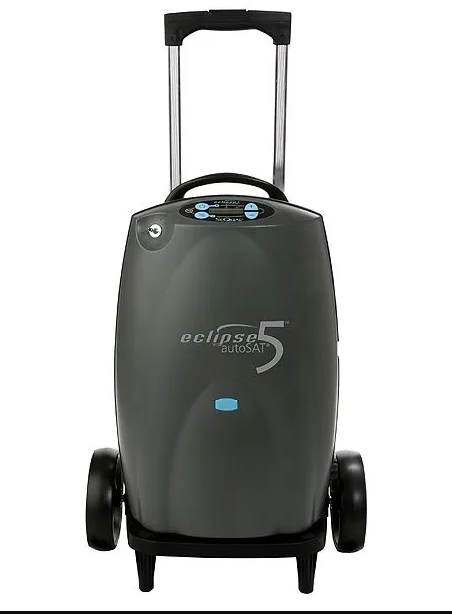The Ultimate Guide To Portable Oxygen Concentrators
Wiki Article
About Portable Oxygen Concentrators
Table of ContentsFascination About Portable Oxygen ConcentratorsPortable Oxygen Concentrators - QuestionsPortable Oxygen Concentrators - QuestionsFascination About Portable Oxygen Concentrators
Fixed oxygen concentrators were as soon as the standard, but these containers could weigh 50 pounds and were very cumbersome (Portable Oxygen Concentrators). Now, portable oxygen concentrators get the work done, and they can suit a bag or bag! The only point you need to keep in mind is that portable concentrators have much more restricted oxygen delivery capacitiesThere are two primary kinds of portable oxygen concentrators: pulse dose and continual flow. As the name recommends, pulse dose concentrators supply oxygen intermittently, only triggering when you breathe in. This kind of tool is typically recommended for COPD individuals with limited oxygen needs, as the amount of O2 that a pulse dose concentrator can provide is reasonably reduced.
This device can provide up to 3,000 m, L of oxygen every min, while pulse dose gadgets have a tendency to top out at 1250 m, L. Continuous circulation tools are the go-to for the majority of COPD people, as they're suitable for people who require 2 to 5 liters of oxygen a minute.
Since you have this overview to the various types of mobile oxygen devices, choose the ideal device with the aid of your physician. You can explore our blog sites for more information concerning the types of portable oxygen readily available and our various other products, like tubes and cannulas. Or you can contact us straight with any type of particular concerns you might have.
Portable Oxygen Concentrators - Questions
We questioned just how well these portable oxygen concentrators would work in healthcare facilities. POC concentrators increase the proportion of oxygen in ambient air people take a breath in, whenever they need an increase.When it pertains to mobile oxygen treatment, there are two primary options for shipment. These are portable oxygen cyndrical tubes which consist of pressed oxygen gas, or oxygen concentrators, which use a battery powered system to press and filter air, in order to produce a regular supply of concentrated oxygen. In this message, AMS Compound Cylinders Technical Director, Tony Morrin, contrasts both, taking a look at the pros and cons of each oxygen shipment system for NHS clinical oxygen customers in regards to patient autonomy.

Mobile Oxygen Concentrator Oxygen purity is continually greater when provided from cyndrical tubes it never drops below 99. Whilst oxygen concentrators can be helpful for clients that need a lower flow of oxygen, cyndrical tubes supply greater concentrations that can be much more appropriate for clients with high flow requirements.
Everything about Portable Oxygen Concentrators
Both systems need the patient to lug about equipment. For cyndrical tubes, this will include lugging a bag (and sometimes a trolley) and for mobile oxygen concentrators this will include the bag, cart and power battery charger. Weight smart, mobile oxygen concentrators can be similar in weight, or in some cases, lighter than typical aluminium cylinder systems.
They will need to improve dramatically if they are to offer the exact same degree of performance as comparable composite cyndrical tubes. Oxygen constantly lugs a safety Visit Website risk. On one pop over to this site hand, ought to cyndrical tubes spring a leakage, they can create an oxygen rich atmosphere that can lead to an increase in fire danger.

The difference is that there are significant upfront expenses to purchasing a mobile oxygen concentrator, yet lower running prices utilizing cyndrical tubes makes it possible for the purchaser to spread out the expense over an extended time period. One minor disadvantage of a portable oxygen concentrator is the sound portable systems make a significant quantity of noise throughout operation, which several people discover disruptive.
The Facts About Portable Oxygen Concentrators Revealed

Our premium carbon composite cylinders offer high stress (300 Bar), low weight, and NLL (Non-Limited Life) efficiency, and are certified for use worldwide. More details concerning AMS Compound Cylinders review Ltd can be found at .
Oxygen concentrators are developed with user flexibility in mind. Whether it's a desktop computer version for home usage or a smaller, light-weight design for on-the-go, these devices permit individuals to move easily without being tethered to a fixed system. Particularly for the ones specifically made for transportability, people can lug them around, assisting in travel and everyday activities with simplicity.
Among the significant conveniences of making use of an oxygen concentrator is the removal of the constant need to fill up oxygen containers. This not only lowers the logistical obstacles and recurrent prices connected with refills but additionally makes certain that the individual has a more foreseeable and consistent source of oxygen. Oxygen concentrators are designed to fit perfectly into the home setting.
Report this wiki page